Wave Climate Change in the North Sea and Baltic Sea
Abstract
1. Introduction
2. Wave Model Configuration and Experimental Design
2.1. Observation Datasets
2.2. Wave Hindcasts
3. Wave Climate Simulation over the Historical Period (1980–2005)
3.1. Validation at the Observation Positions
3.2. Validation over the Regional Domains
4. Wave Climate Projection (2075–2100)
5. Summary and Conclusions
Author Contributions
Funding
Acknowledgments
Conflicts of Interest
Appendix A. Mean Wave Climate Change

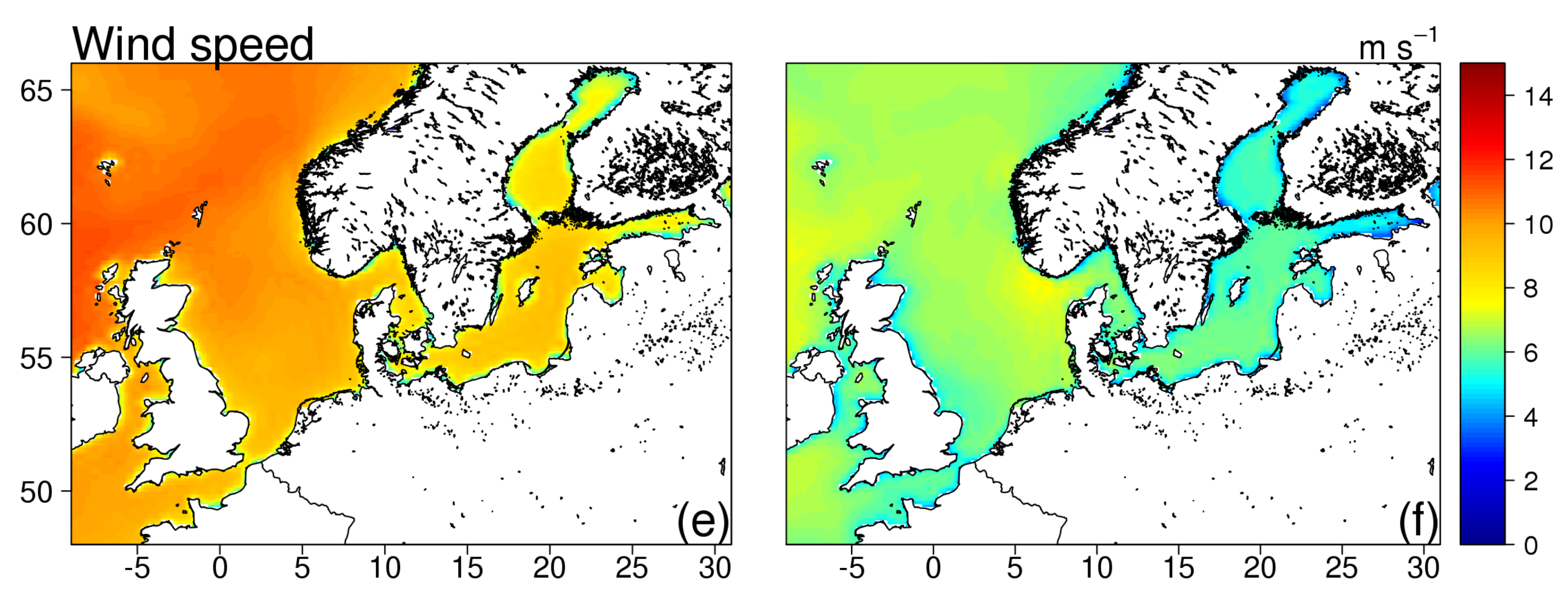
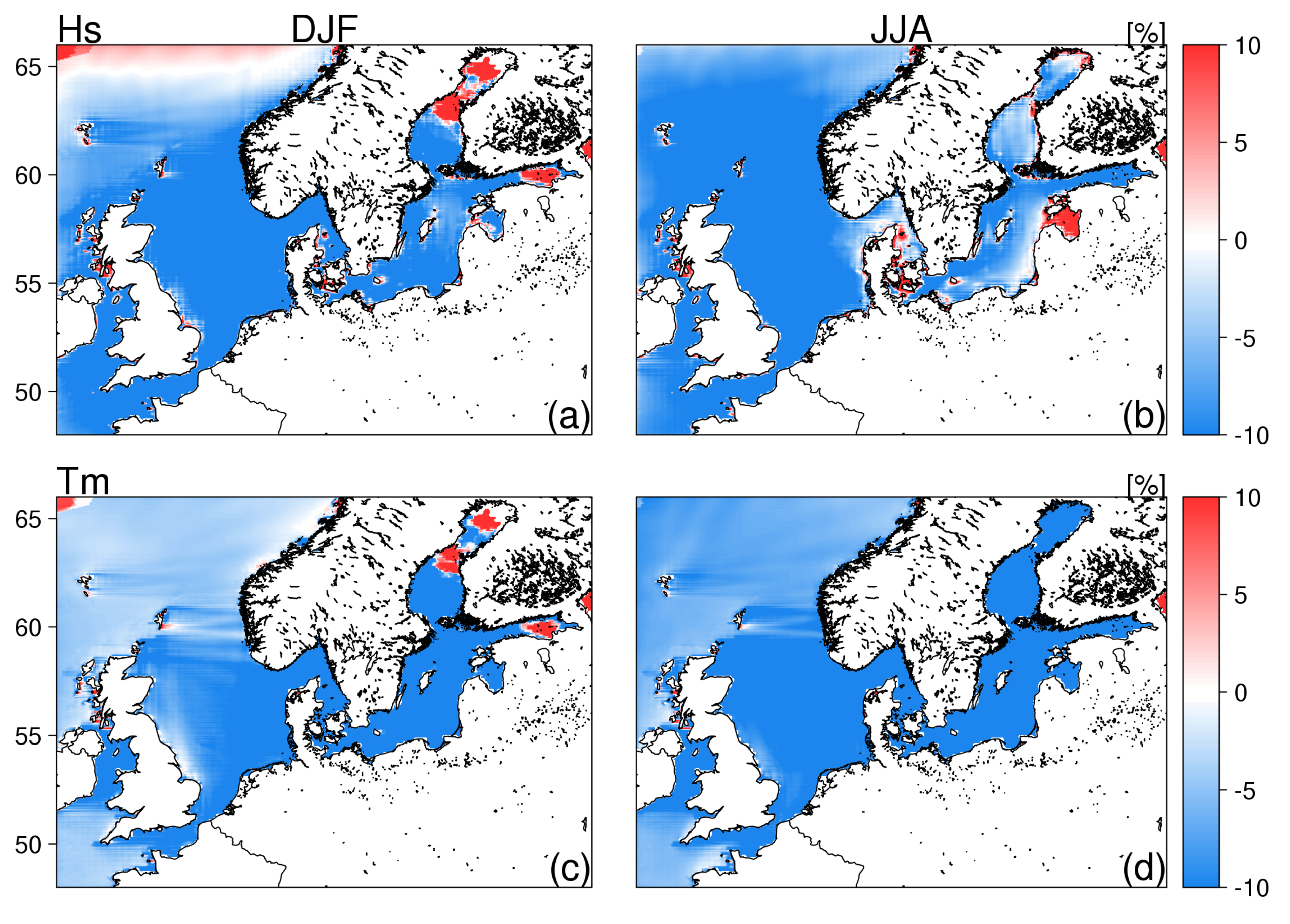
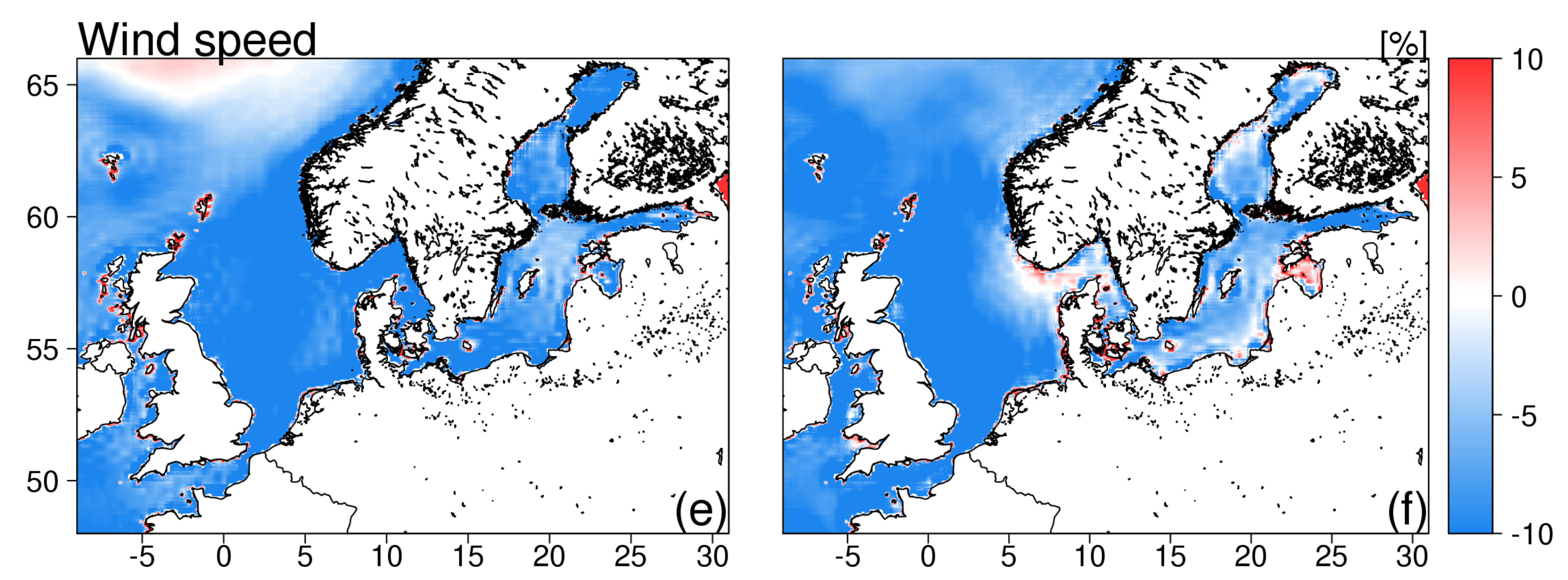
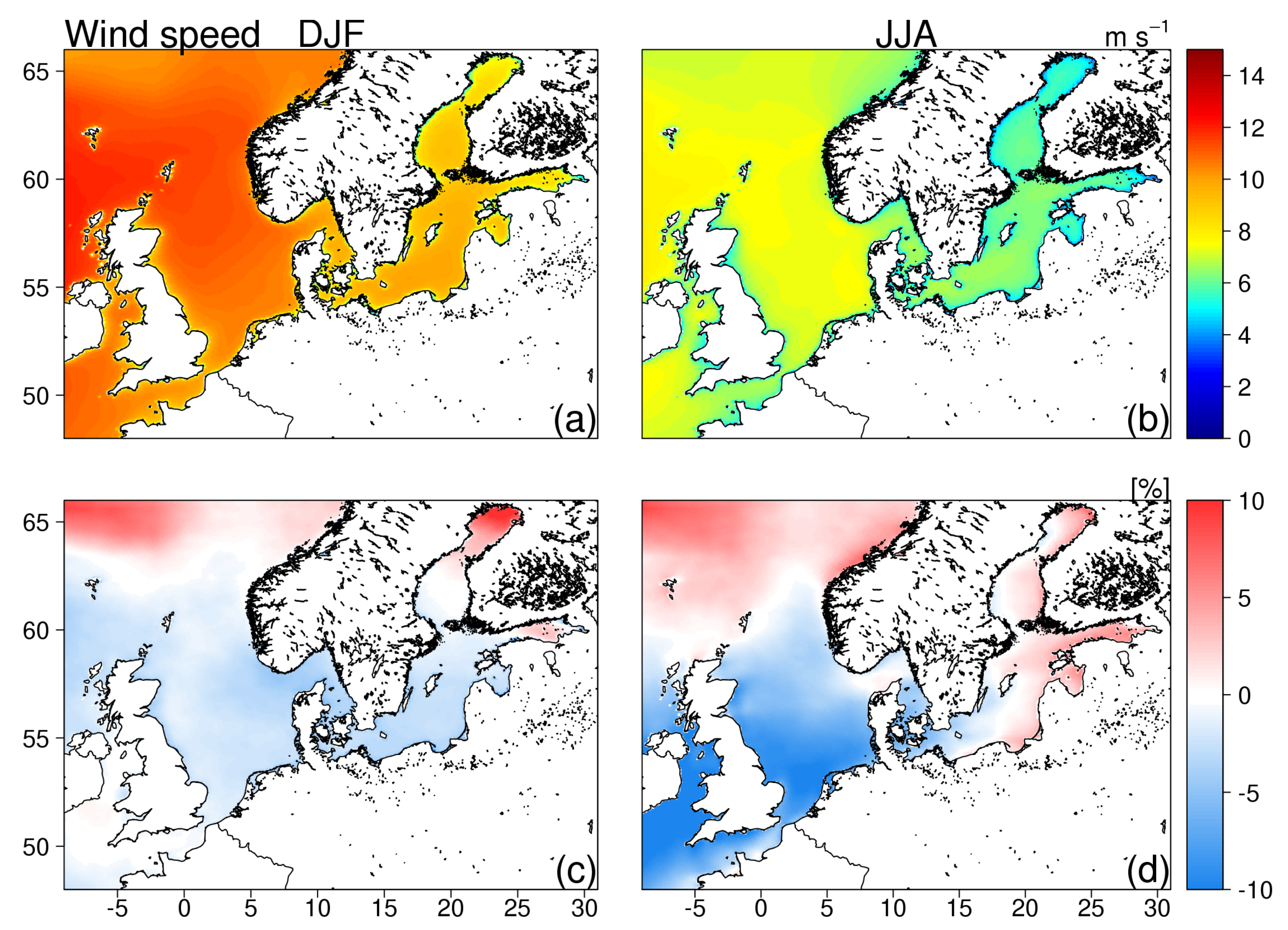
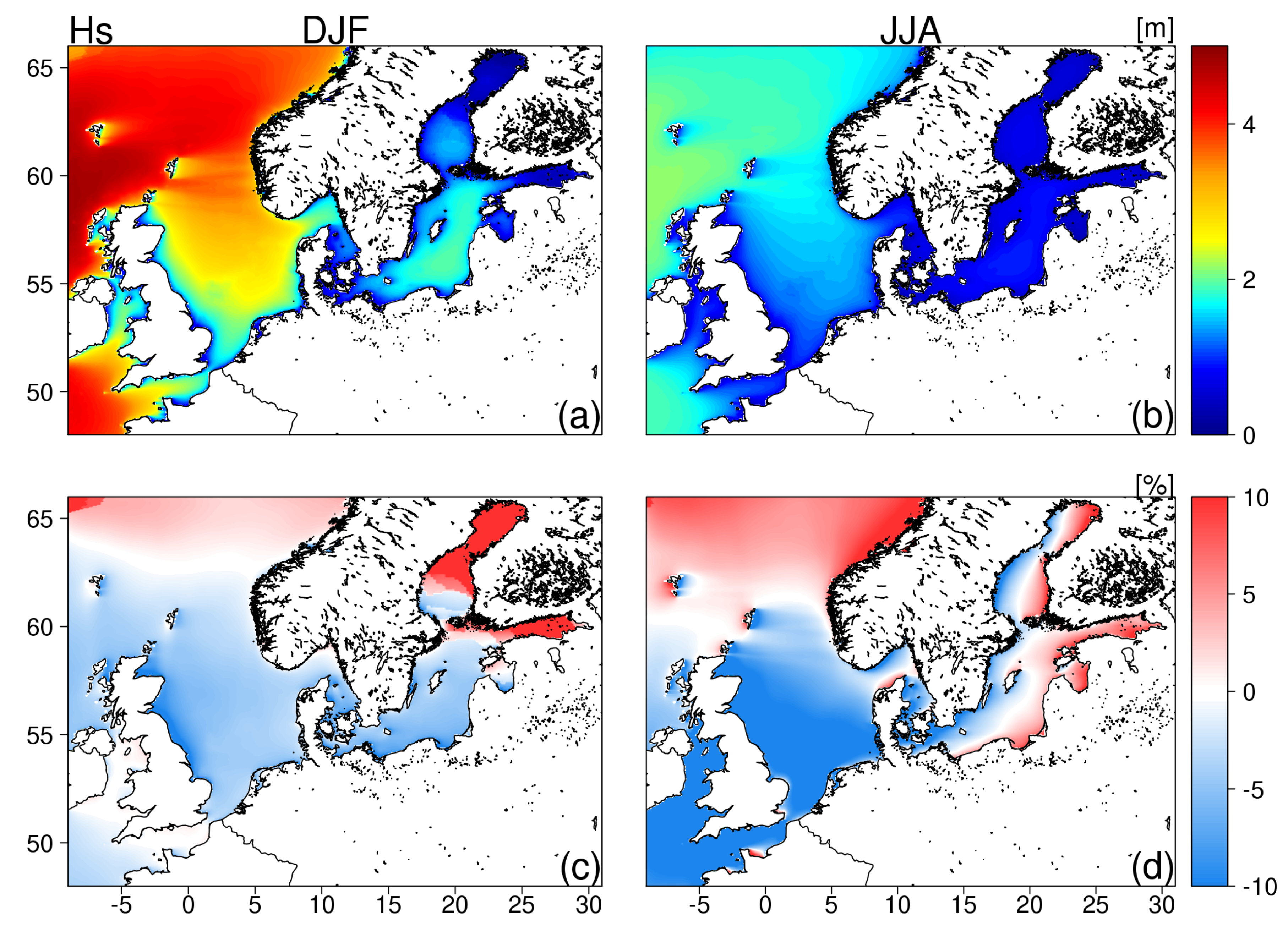
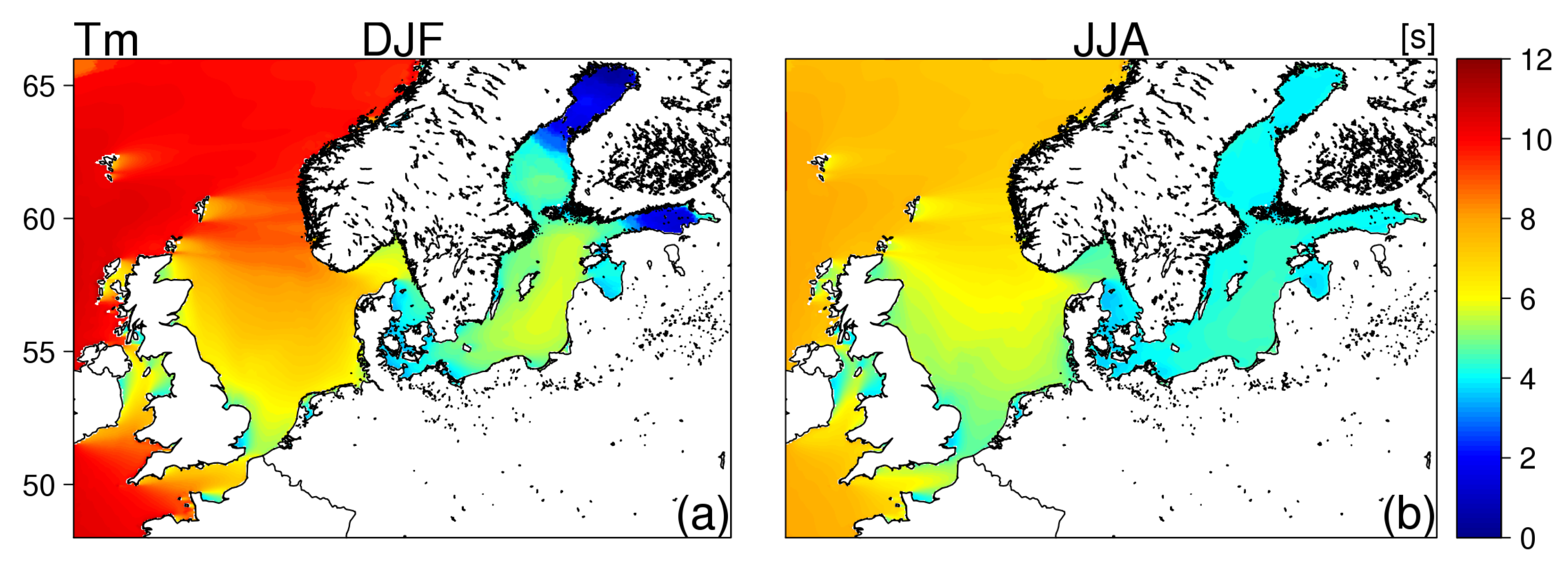
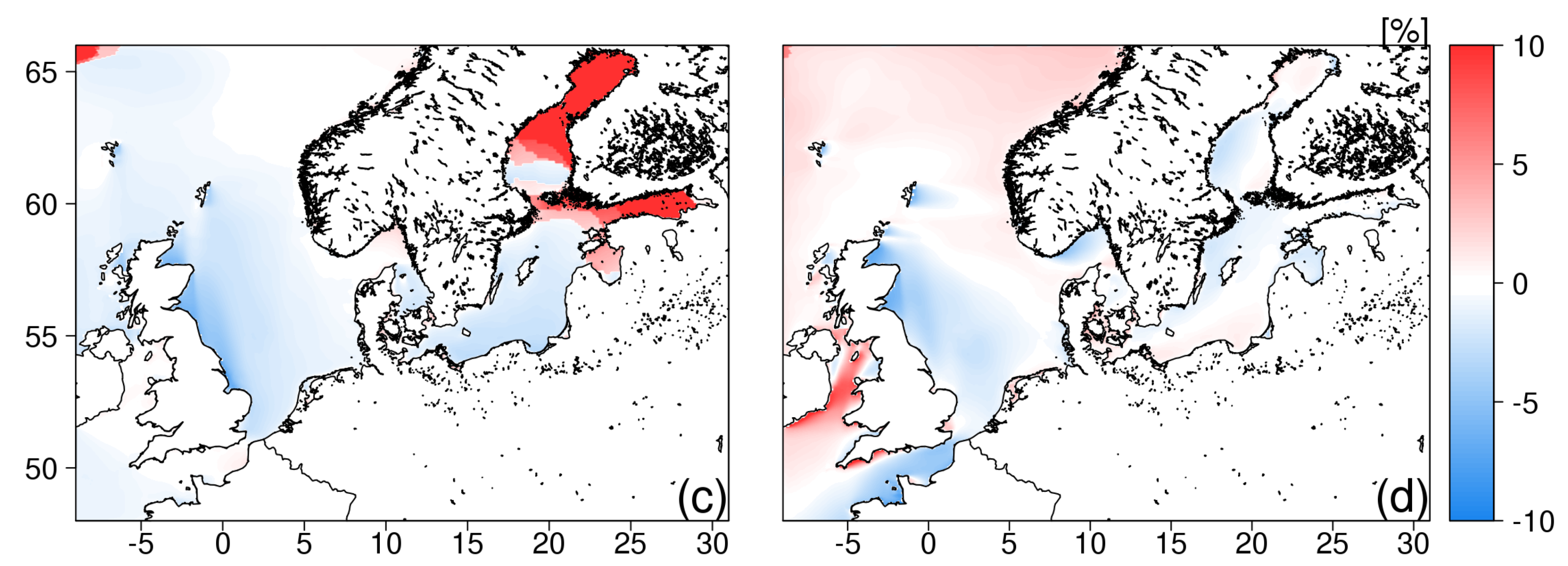
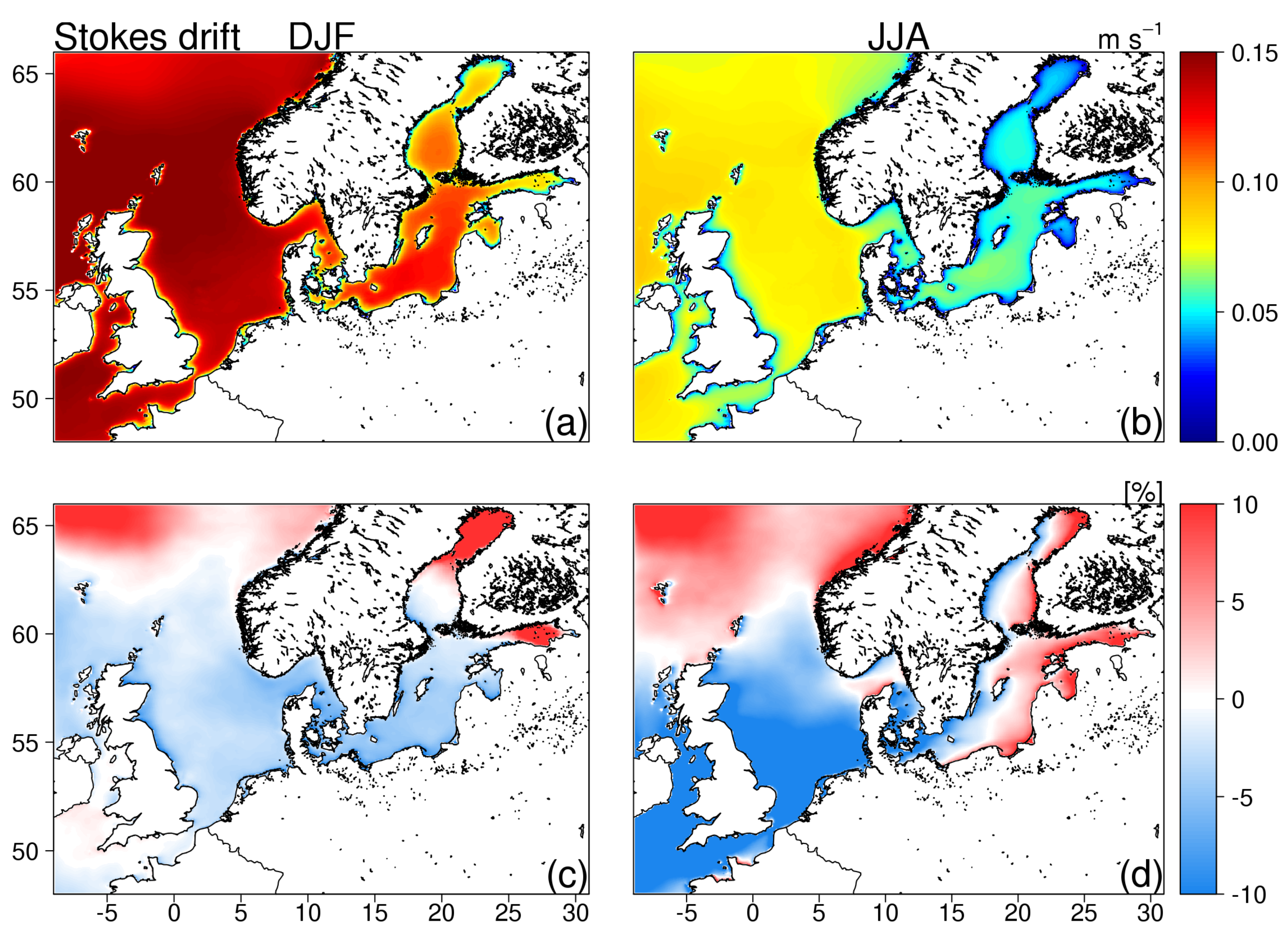
References
- Hemer, M.A.; Fan, Y.; Mori, N.; Semedo, A.; Wang, X.L. Projected changes in wave climate from a multi-model ensemble. Nat. Clim. Chang. 2013, 3, 471. [Google Scholar] [CrossRef]
- Breivik, Ø.; Carrasco, A.; Staneva, J.; Behrens, A.; Semedo, A.; Bidlot, J.R.; Aarnes, O.J. Global Stokes Drift Climate under the RCP8.5 Scenario. J. Clim. 2019, 32, 1677–1691. [Google Scholar] [CrossRef]
- Bricheno, L.M.; Wolf, J. Future Wave Conditions of Europe, in Response to High-End Climate Change Scenarios. J. Geophys. Res. Ocean. 2018, 123, 8762–8791. [Google Scholar] [CrossRef]
- Wolf, J.; Woolf, D.K. Waves and climate change in the north-east Atlantic. Geophys. Res. Lett. 2006, 33. [Google Scholar] [CrossRef]
- Semedo, A.; Dobrynin, M.; Lemos, G.; Behrens, A.; Staneva, J.; de Vries, H.; Sterl, A.; Bidlot, J.R.; Miranda, P.M.A.; Murawski, J. CMIP5-Derived Single-Forcing, Single-Model, and Single-Scenario Wind-Wave Climate Ensemble: Configuration and Performance Evaluation. J. Mar. Sci. Eng. 2018, 6, 90. [Google Scholar] [CrossRef]
- Stocker, T.; Qin, D.; Plattner, G.K.; Alexander, L.; Allen, S.; Bindoff, N.; Breon, F.M.; Church, J.; Cubasch, U.; Emori, S.; et al. Technical Summary. In Climate Change 2013: The Physical Science Basis. Contribution of Working Group I to the Fifth Assessment Report of the Intergovernmental Panel on Climate Change; Stocker, T., Qin, D., Plattner, G.K., Tignor, M., Allen, S., Boschung, J., Nauels, A., Xia, Y., Bex, V., Midgley, P., Eds.; Cambridge University Press: Cambridge, UK; New York, NY, USA, 2013; pp. 33–115. [Google Scholar] [CrossRef]
- Rhein, M.; Rintoul, S.; Aoki, S.; Campos, E.; Chambers, D.; Feely, R.; Gulev, S.; Johnson, G.; Josey, S.; Kostianoy, A.; et al. Observations: Ocean. In Climate Change 2013: The Physical Science Basis. Contribution of Working Group I to the Fifth Assessment Report of the Intergovernmental Panel on Climate Change; Stocker, T., Qin, D., Plattner, G.K., Tignor, M., Allen, S., Boschung, J., Nauels, A., Xia, Y., Bex, V., Midgley, P., Eds.; Cambridge University Press: Cambridge, UK; New York, NY, USA, 2013; pp. 255–316. [Google Scholar] [CrossRef]
- Church, J.; Clark, P.; Cazenave, A.; Gregory, J.; Jevrejeva, S.; Levermann, A.; Merrifield, M.; Milne, G.; Nerem, R.; Nunn, P.; et al. Sea Level Change. In Climate Change 2013: The Physical Science Basis. Contribution of Working Group I to the Fifth Assessment Report of the Intergovernmental Panel on Climate Change; Stocker, T., Qin, D., Plattner, G.K., Tignor, M., Allen, S., Boschung, J., Nauels, A., Xia, Y., Bex, V., Midgley, P., Eds.; Cambridge University Press: Cambridge, UK; New York, NY, USA, 2013; pp. 1137–1216. [Google Scholar] [CrossRef]
- Cavaleri, L.; Fox-Kemper, B.; Hemer, M. Wind Waves in the Coupled Climate System. Bull. Am. Meteorol. Soc. 2012, 93, 1651–1661. [Google Scholar] [CrossRef]
- Lemos, G.; Semedo, A.; Dobrynin, M.; Behrens, A.; Staneva, J.; Bidlot, J.R.; Miranda, P.M. Mid-twenty-first century global wave climate projections: Results from a dynamic CMIP5 based ensemble. Glob. Planet. Chang. 2019, 172, 69–87. [Google Scholar] [CrossRef]
- Taylor, K.E.; Stouffer, R.J.; Meehl, G.A. An Overview of CMIP5 and the Experiment Design. Bull. Am. Meteorol. Soc. 2012, 93, 485–498. [Google Scholar] [CrossRef]
- Moss, R.H.; Edmonds, J.A.; Hibbard, K.A.; Manning, M.R.; Rose, S.K.; Van Vuuren, D.P.; Carter, T.R.; Emori, S.; Kainuma, M.; Kram, T.; et al. The next generation of scenarios for climate change research and assessment. Nature 2010, 463, 747. [Google Scholar] [CrossRef]
- Nakicenovic, N.; Alcamo, J.; Grubler, A.; Riahi, K.; Roehrl, R.; Rogner, H.H.; Victor, N. Special Report on Emissions Scenarios (SRES), A Special Report of Working Group III of the Intergovernmental Panel on Climate Change; Cambridge University Press: Cambridge, UK, 2000. [Google Scholar]
- Bitner-Gregersen, E.M.; Vanem, E.; Gramstad, O.; Hørte, T.; Aarnes, O.J.; Reistad, M.; Breivik, Ø.; Magnusson, A.K.; Natvig, B. Climate change and safe design of ship structures. Ocean Eng. 2018, 149, 226–237. [Google Scholar] [CrossRef]
- Dobrynin, M.; Murawski, J.; Baehr, J.; Ilyina, T. Detection and Attribution of Climate Change Signal in Ocean Wind Waves. J. Clim. 2015, 28, 1578–1591. [Google Scholar] [CrossRef]
- Wang, X.L.; Feng, Y.; Swail, V.R. Changes in global ocean wave heights as projected using multimodel CMIP5 simulations. Geophys. Res. Lett. 2014, 41, 1026–1034. [Google Scholar] [CrossRef]
- Casas-Prat, M.; Wang, X.; Swart, N. CMIP5-based global wave climate projections including the entire Arctic Ocean. Ocean Model. 2018, 123, 66–85. [Google Scholar] [CrossRef]
- Erikson, L.; Hegermiller, C.; Barnard, P.; Ruggiero, P.; van Ormondt, M. Projected wave conditions in the Eastern North Pacific under the influence of two CMIP5 climate scenarios. Ocean Model. 2015, 96, 171–185. [Google Scholar] [CrossRef]
- Aarnes, O.J.; Reistad, M.; Breivik, Ø.; Bitner-Gregersen, E.; Ingolf Eide, L.; Gramstad, O.; Magnusson, A.K.; Natvig, B.; Vanem, E. Projected changes in significant wave height toward the end of the 21st century: Northeast Atlantic. J. Geophys. Res. Ocean. 2017, 122, 3394–3403. [Google Scholar] [CrossRef]
- Grabemann, I.; Groll, N.; Möller, J.; Weisse, R. Climate change impact on North Sea wave conditions: A consistent analysis of ten projections. Ocean Dyn. 2015, 65, 255–267. [Google Scholar] [CrossRef]
- Groll, N.; Grabemann, I.; Hünicke, B.; Meese, M. Baltic Sea wave conditions under climate change scenarios. Boreal Environ. Res. 2017, 22, 1–12. [Google Scholar]
- Cavaleri, L.; Abdalla, S.; Benetazzo, A.; Bertotti, L.; Bidlot, J.R.; Breivik, Ø.; Carniel, S.; Jensen, R.; Portilla-Yandun, J.; Rogers, W.; et al. Wave modelling in coastal and inner seas. Prog. Oceanogr. 2018, 167, 164–233. [Google Scholar] [CrossRef]
- WAMDI-Group. The WAM Model - A Third Generation Ocean Wave Prediction Model. J. Phys. Oceanogr. 1988, 18, 1775–1810. [Google Scholar] [CrossRef]
- Komen, G.J.; Hasselmann, K.; Cavaleri, L.; Donelan, M.; Janssen, P.A.E.M.; Hasselmann, S. Dynamics and Modelling of Ocean Waves. J. Fluid Mech. 1994, 307, 375–376. [Google Scholar] [CrossRef]
- Günther, H.; Hasselmann, S.; Janssen, P. The WAM Model Cycle 4.0. User Manual; Technical Report; Deutsches Klimarechenzentrum: Hamburg, Germany, 1992. [Google Scholar]
- ECMWF. Part VII: ECMWF Wave Model. In IFS Documentation CY45R1; Number 7 in IFS Documentation CY45R1; ECMWF: Reading, UK, 2018. [Google Scholar]
- Staneva, J.; Behrens, A.; Wahle, K. Wave modelling for the German Bight coastal-ocean predicting system. J. Phys. Conf. Ser. 2015, 633, 012117. [Google Scholar] [CrossRef]
- Strandberg, G.; Bärring, L.; Hansson, U.; Jansson, C.; Jones, C.; Kjellström, E.; Kupiainen, M.; Nikulin, G.; Samuelsson, P.; Ullerstig, A. CORDEX Scenarios for Europe from the Rossby Centre Regional Climate Model RCA4; Technical Report 116; Climate research–Rossby Centre: Norrkoping, Sweden, 2015. [Google Scholar]
- Hazeleger, W.; Severijns, C.; Semmler, T.; Ştefănescu, S.; Yang, S.; Wang, X.; Wyser, K.; Dutra, E.; Baldasano, J.M.; Bintanja, R.; et al. EC-Earth. Bull. Am. Meteorol. Soc. 2010, 91, 1357–1364. [Google Scholar] [CrossRef]
- Hazeleger, W.; Wang, X.; Severijns, C.; Ştefănescu, S.; Bintanja, R.; Sterl, A.; Wyser, K.; Semmler, T.; Yang, S.; van den Hurk, B.; et al. EC-Earth V2.2: Description and validation of a new seamless earth system prediction model. Clim. Dyn. 2012, 39, 2611–2629. [Google Scholar] [CrossRef]
- Brodeau, L.; Koenigk, T. Extinction of the northern oceanic deep convection in an ensemble of climate model simulations of the 20th and 21st centuries. Clim. Dyn. 2016, 46, 2863–2882. [Google Scholar] [CrossRef]
- Caian, M.; Koenigk, T.; Döscher, R.; Devasthale, A. An interannual link between Arctic sea-ice cover and the North Atlantic Oscillation. Clim. Dyn. 2018, 50, 423–441. [Google Scholar] [CrossRef]
- Hersbach, H.; Dee, D. ERA5 reanalysis is in production. ECMWF Newslett. 2016, 147, 7. [Google Scholar]
- Reistad, M.; Breivik, Ø.; Haakenstad, H.; Aarnes, O.J.; Furevik, B.R.; Bidlot, J.R. A high-resolution hindcast of wind and waves for the North Sea, the Norwegian Sea, and the Barents Sea. J. Geophys. Res. Ocean. 2011, 116. [Google Scholar] [CrossRef]
- Bidlot, J.R.; Holt, M.W. Verification of Operational Global and Regional Wave Forecasting Systems against Measurements from Moored Buoys; Jcomm Technical Report; WMO & IOC: Geneva, Switzerland, 2006. [Google Scholar]
- Bidlot, J.R.; Holmes, D.J.; Wittmann, P.A.; Lalbeharry, R.; Chen, H.S. Intercomparison of the Performance of Operational Ocean Wave Forecasting Systems with Buoy Data. Weather Forecast. 2002, 17, 287–310. [Google Scholar] [CrossRef]
- Passaro, M.; Cipollini, P.; Vignudelli, S.; Quartly, G.D.; Snaith, H.M. ALES: A multi-mission adaptive subwaveform retracker for coastal and open ocean altimetry. Remote Sens. Environ. 2014, 145, 173–189. [Google Scholar] [CrossRef]
- Passaro, M.; Fenoglio-Marc, L.; Cipollini, P. Validation of Significant Wave Height From Improved Satellite Altimetry in the German Bight. IEEE Trans. Geosci. Remote Sens. 2015, 53, 2146–2156. [Google Scholar] [CrossRef]
- Uppala, S.M.; Kållberg, P.; Simmons, A.; Andrae, U.; Bechtold, V.D.C.; Fiorino, M.; Gibson, J.; Haseler, J.; Hernandez, A.; Kelly, G.; et al. The ERA-40 re-analysis. Q. J. R. Meteorol. Soc. 2005, 131, 2961–3012. [Google Scholar] [CrossRef]
- Aarnes, O.J.; Breivik, Ø.; Reistad, M. Wave Extremes in the Northeast Atlantic. J. Clim. 2012, 25, 1529–1543. [Google Scholar] [CrossRef]
- Semedo, A.; Vettor, R.; Breivik, Ø.; Sterl, A.; Reistad, M.; Soares, C.G.; Lima, D. The wind sea and swell waves climate in the Nordic seas. Ocean Dyn. 2015, 65, 223–240. [Google Scholar] [CrossRef]
- Undén, P.; Rontu, L.; Jarvinen, H.; Lynch, P.; Calvo Sánchez, F.J.; Cats, G.; Cuxart, J.; Eerola, K.; Fortelius, C.; Garcia-Moya, J.A.; et al. HIRLAM-5 Scientific Documentation; Swedish Meteorological and Hydrological Institute: Norrkoping, Sweden, 2002. [Google Scholar]
- Bruserud, K.; Haver, S. Comparison of wave and current measurements to NORA10 and NoNoCur hindcast data in the northern North Sea. Ocean Dyn. 2016, 66, 823–838. [Google Scholar] [CrossRef]
- Dee, D.P.; Uppala, S.M.; Simmons, A.; Berrisford, P.; Poli, P.; Kobayashi, S.; Andrae, U.; Balmaseda, M.; Balsamo, G.; Bauer, d.P.; et al. The ERA-Interim reanalysis: Configuration and performance of the data assimilation system. Q. J. R. Meteorol. Soc. 2011, 137, 553–597. [Google Scholar] [CrossRef]
- ECMWF. ERA5 Documentation. Available online: https://confluence.ecmwf.int/label/CKB/era5 (accessed on 14 March 2019).
- Wiese, A.; Staneva, J.; Schulz-Stellenfleth, J.; Behrens, A.; Fenoglio-Marc, L.; Bidlot, J.R. Synergy of wind wave model simulations and satellite observations during extreme events. Ocean Sci. 2018, 14, 1503–1521. [Google Scholar] [CrossRef]
- Hersbach, H.; de Rosnay, P.; Bell, B.; Schepers, D.; Simmons, A.; Soci, C.; Abdalla, S.; Alonso-Balmaseda, M.; Balsamo, G.; Bechtold, P.; et al. Operational Global Reanalysis: Progress, Future Directions and Synergies with NWP; European Centre for Medium Range Weather Forecasts: Reading, UK, 2018. [Google Scholar]
- ECMWF. ECMWF Wave Model. In IFS Documentation CY46R1; IFS Documentation CY46R1; ECMWF: Reading, UK, 2019. [Google Scholar]
- Bidlot, J.R.; Janssen, P.A.E.M.; Abdalla, S. A revised formulation of ocean wave dissipation and its model impact. In ECMWF Technical Memorandum; ECMWF: Reading, UK, 2007; p. 27. [Google Scholar] [CrossRef]
- Ardhuin, F.; Rogers, E.; Babanin, A.V.; Filipot, J.F.; Magne, R.; Roland, A.; van der Westhuysen, A.; Queffeulou, P.; Lefevre, J.M.; Aouf, L.; et al. Semiempirical Dissipation Source Functions for Ocean Waves. Part I: Definition, Calibration, and Validation. J. Phys. Oceanogr. 2010, 40, 1917–1941. [Google Scholar] [CrossRef]
- Bidlot, J.R. Ocean Wave Model Output Parameters. 2016. Available online: https://software.ecmwf.int/wiki/display/IFS/Official+IFS+Documentation (accessed on 15 January 2019).
- Semedo, A.; Weisse, R.; Behrens, A.; Sterl, A.; Bengtsson, L.; Günther, H. Projection of Global Wave Climate Change toward the End of the Twenty-First Century. J. Clim. 2013, 26, 8269–8288. [Google Scholar] [CrossRef]
- von Storch, H. Spatial Patterns: EOFs and CCA. In Analysis of Climate Variability: Applications of Statistical Techniques; von Storch, H., Navarra, A., Eds.; Springer: Berlin/Heidelberg, Germany, 1995; pp. 227–257. [Google Scholar] [CrossRef]
- Björnsson, H.; Venegas, S. A manual for EOF and SVD analyses of climatic data. CCGCR Rep. 1997, 97, 112–134. [Google Scholar]
- Pierson, W.J., Jr.; Moskowitz, L. A proposed spectral form for fully developed wind seas based on the similarity theory of S. A. Kitaigorodskii. J. Geophys. Res. 1964, 69, 5181–5190. [Google Scholar] [CrossRef]
- Morim, J.; Hemer, M.; Cartwright, N.; Strauss, D.; Andutta, F. On the concordance of 21st century wind-wave climate projections. Glob. Planet. Chang. 2018, 167, 160–171. [Google Scholar] [CrossRef]
- Staneva, J.; Alari, V.; Breivik, Ø.; Bidlot, J.R.; Mogensen, K. Effects of wave-induced forcing on a circulation model of the North Sea. Ocean Dyn. 2017, 67, 81–101. [Google Scholar] [CrossRef]
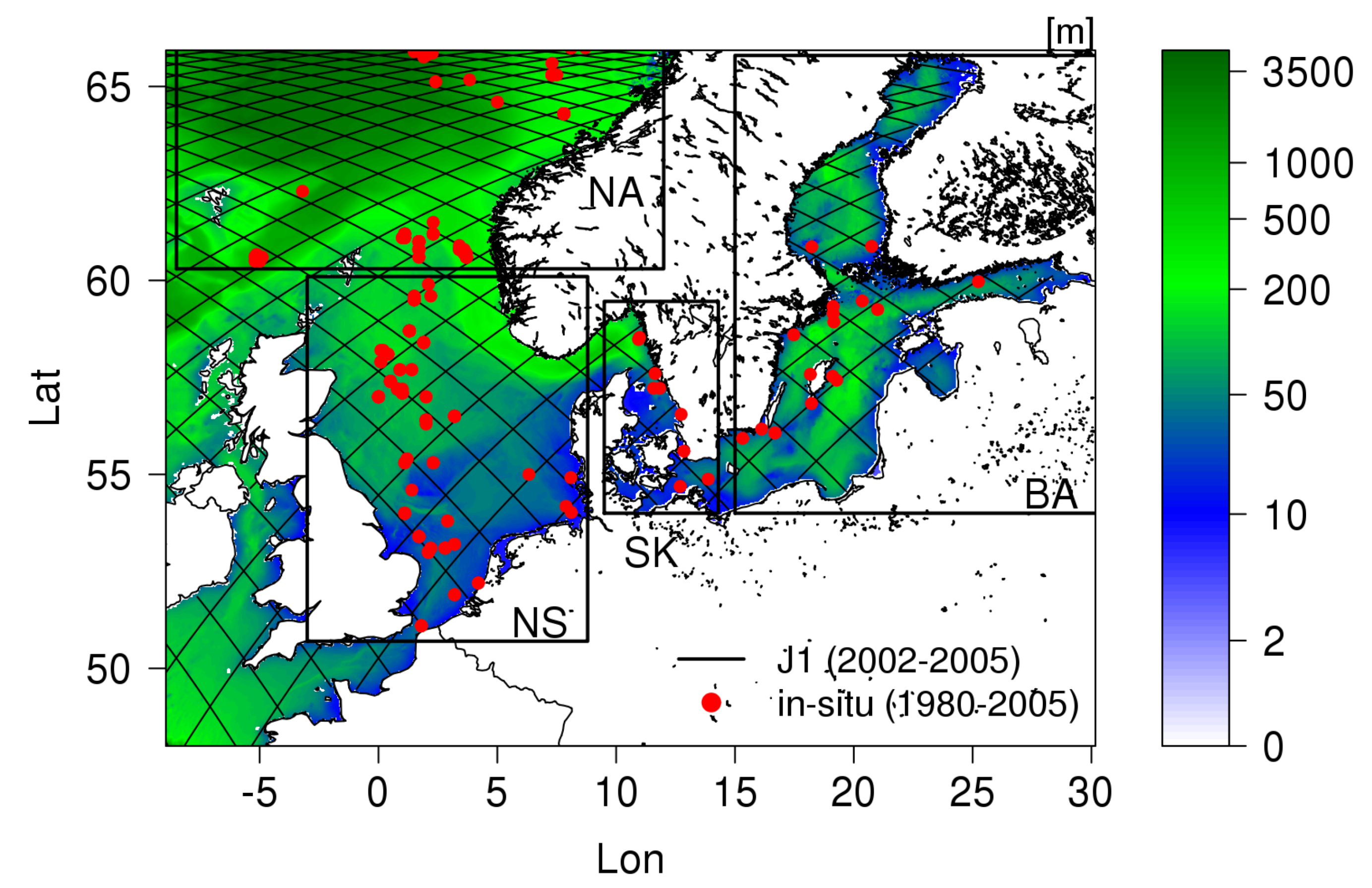
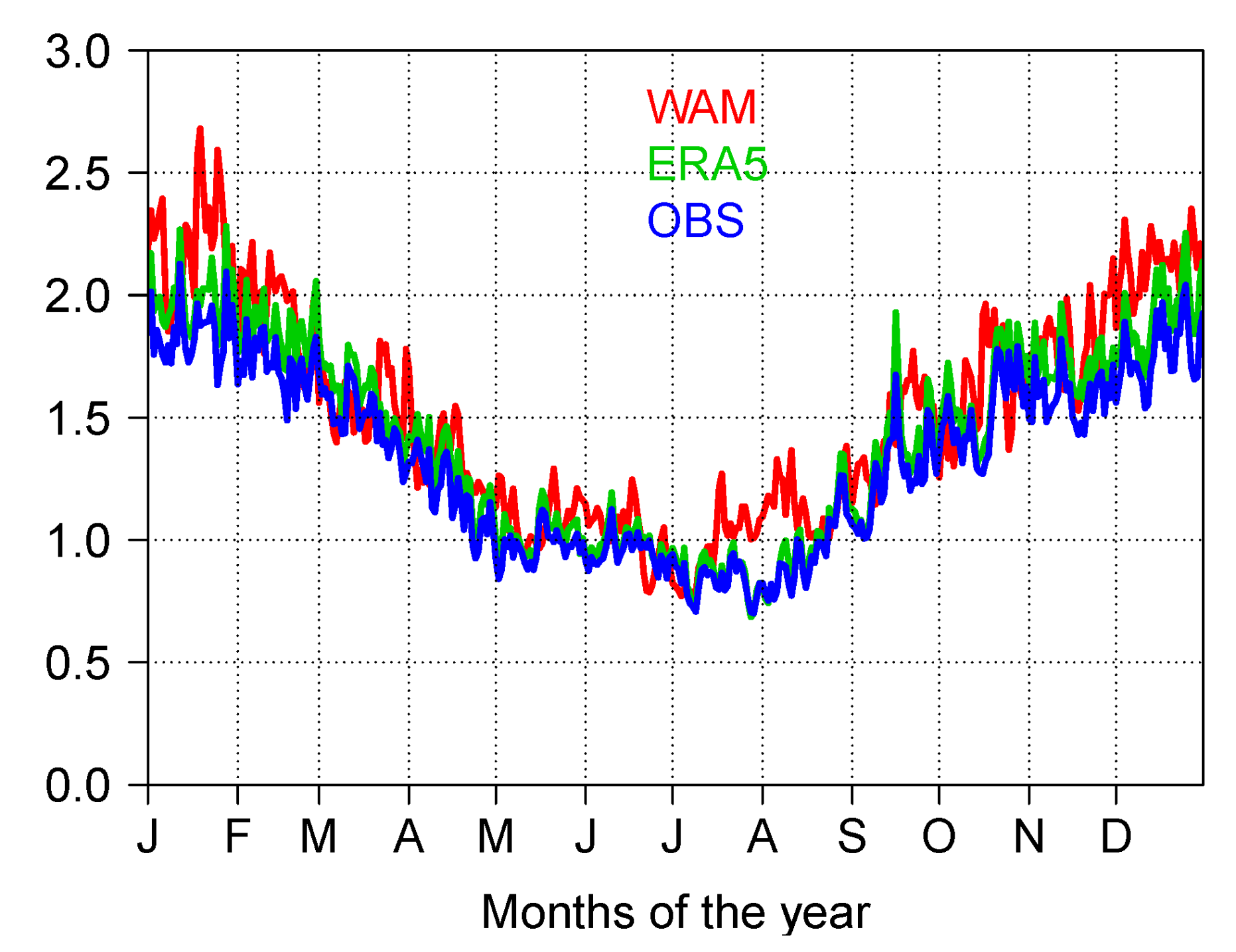
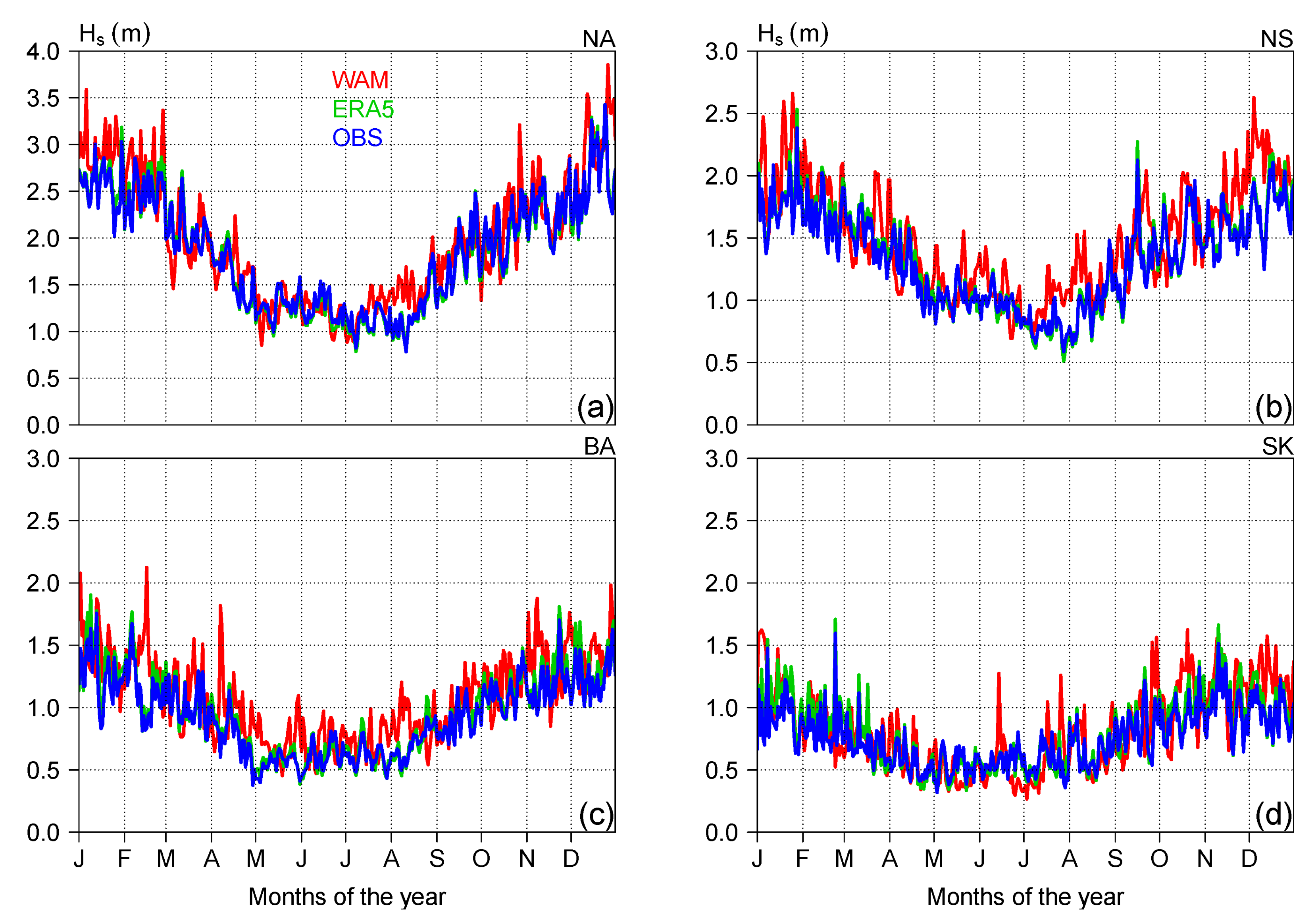
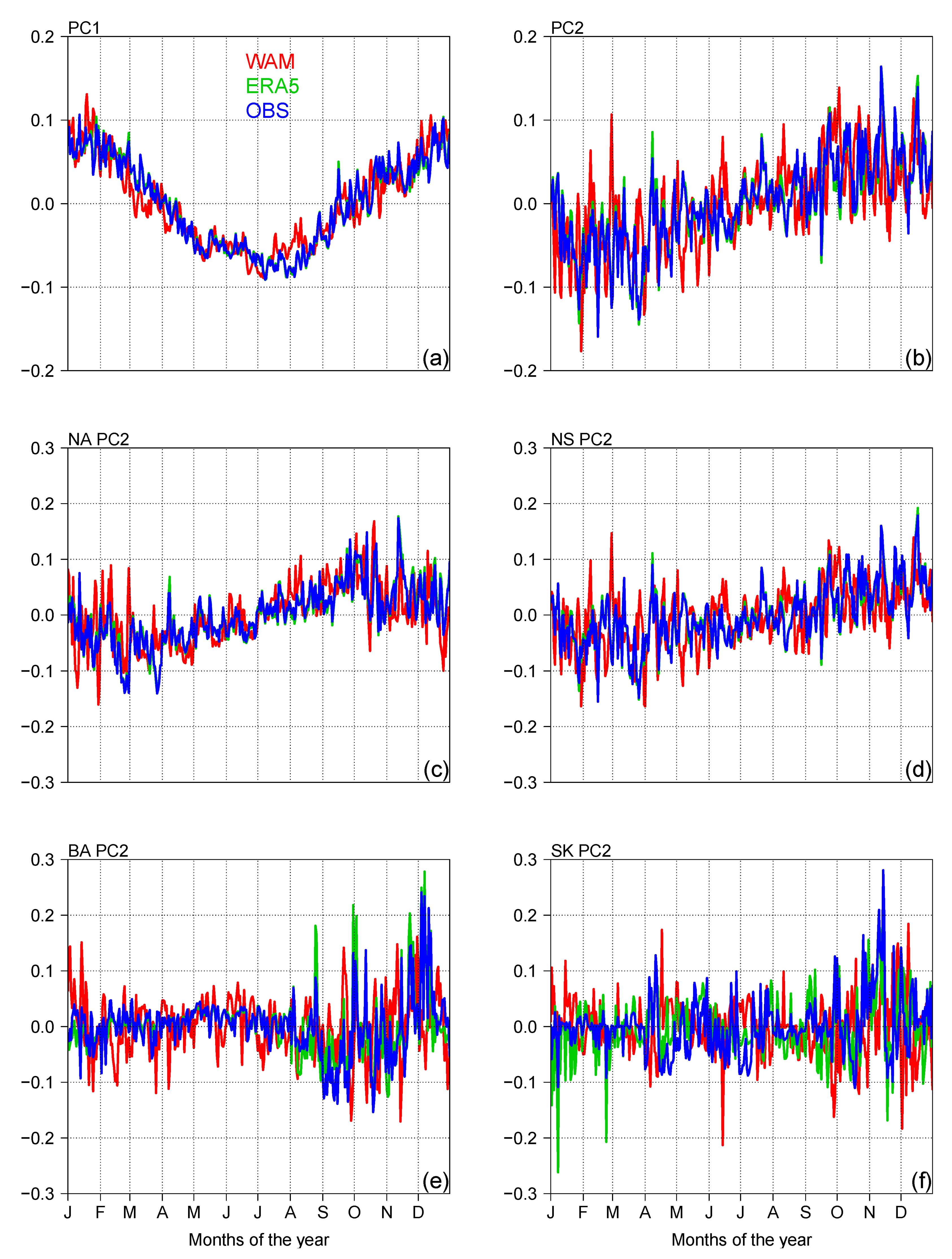
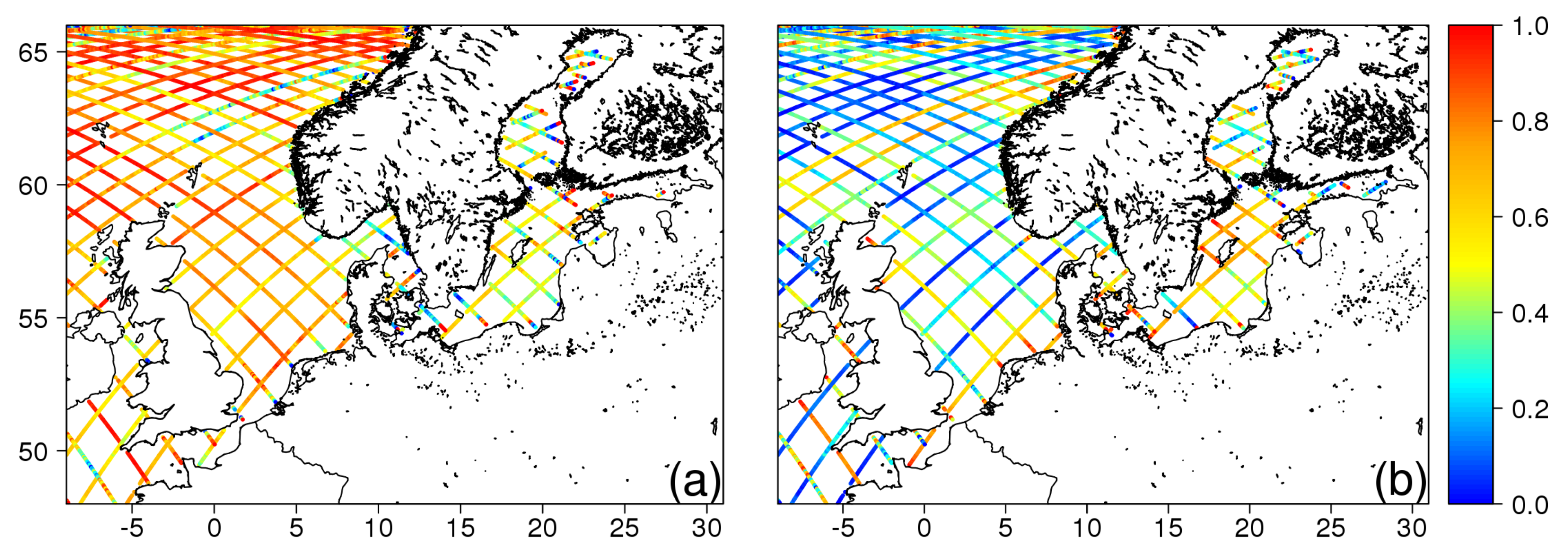
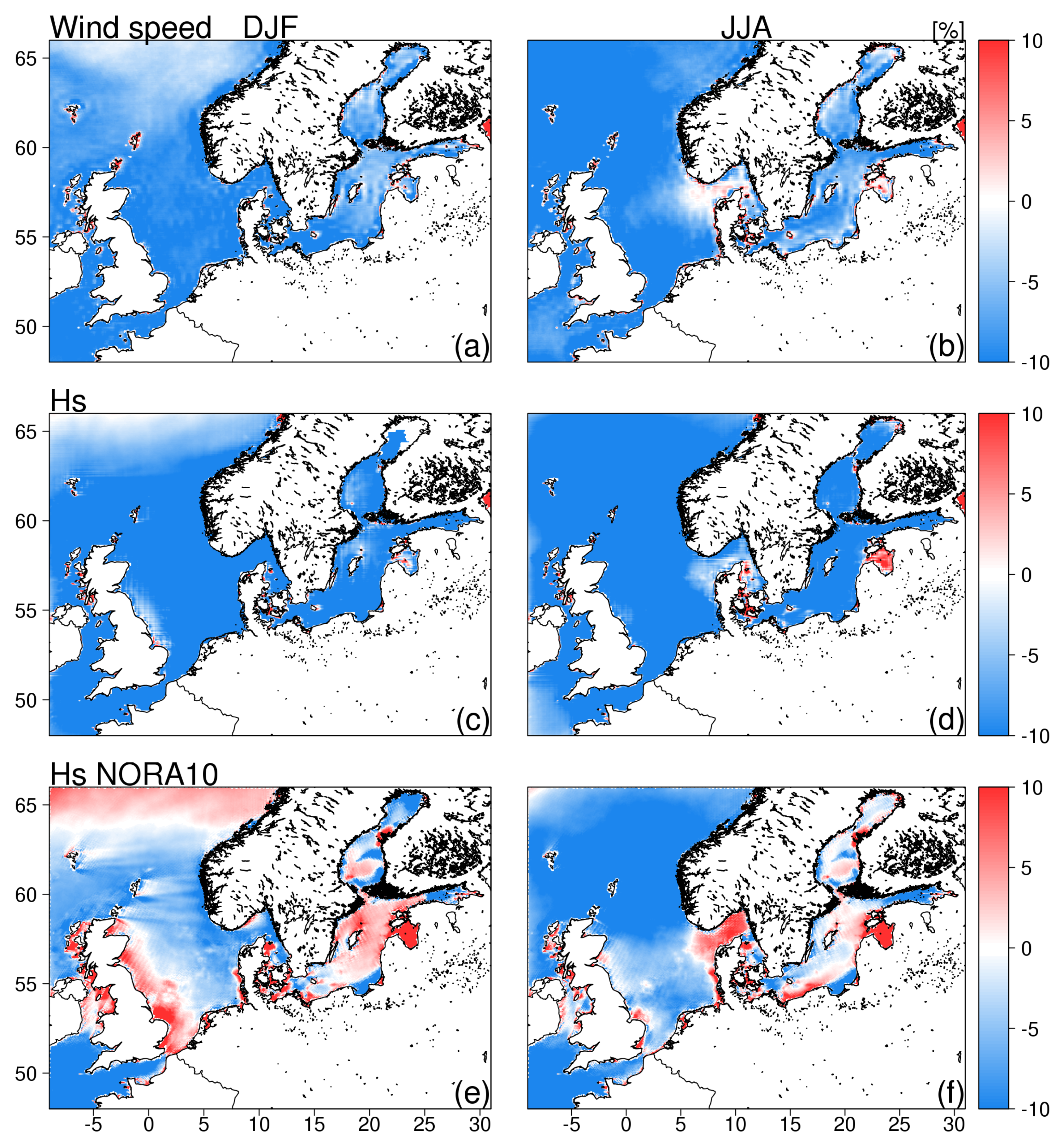
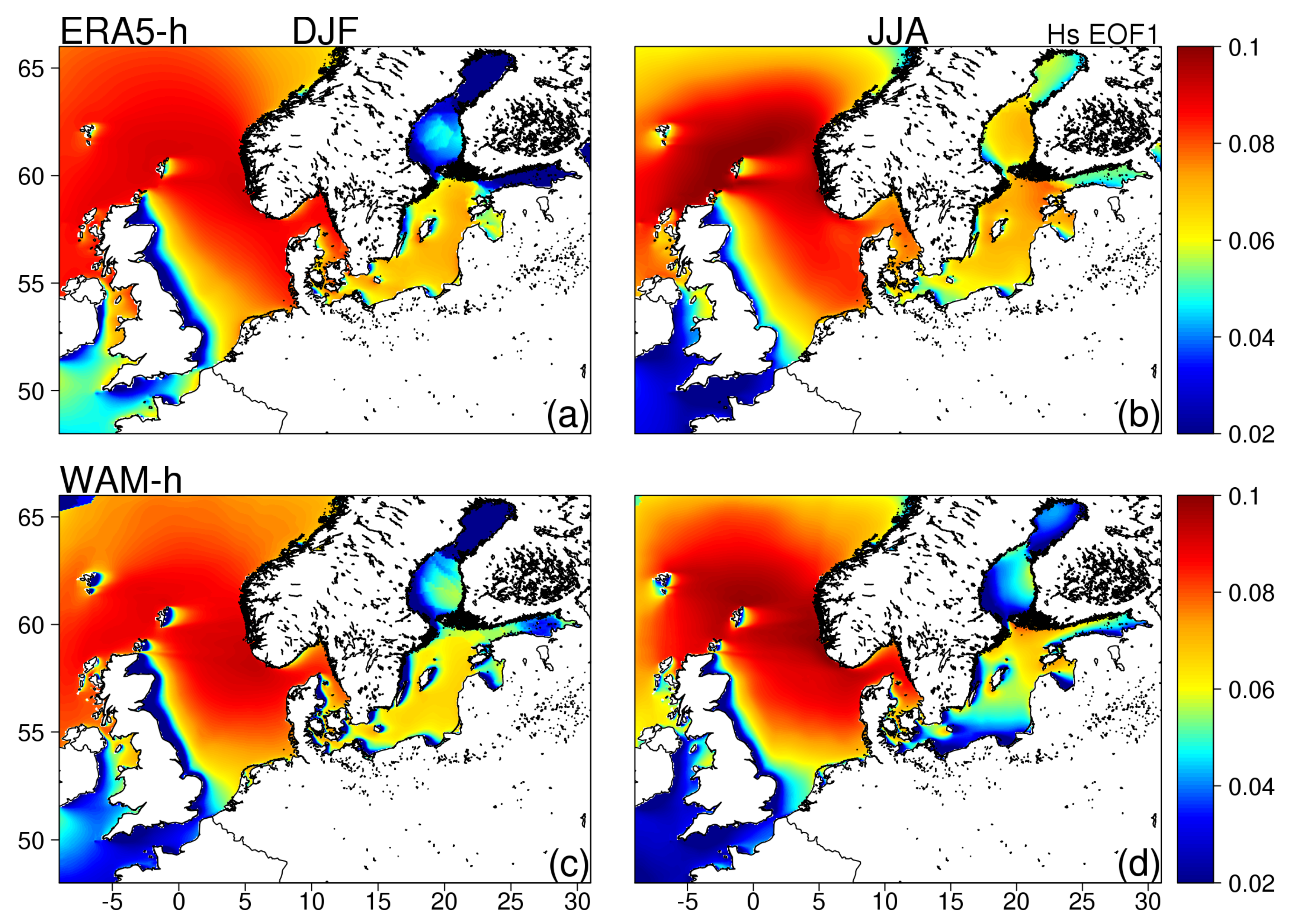
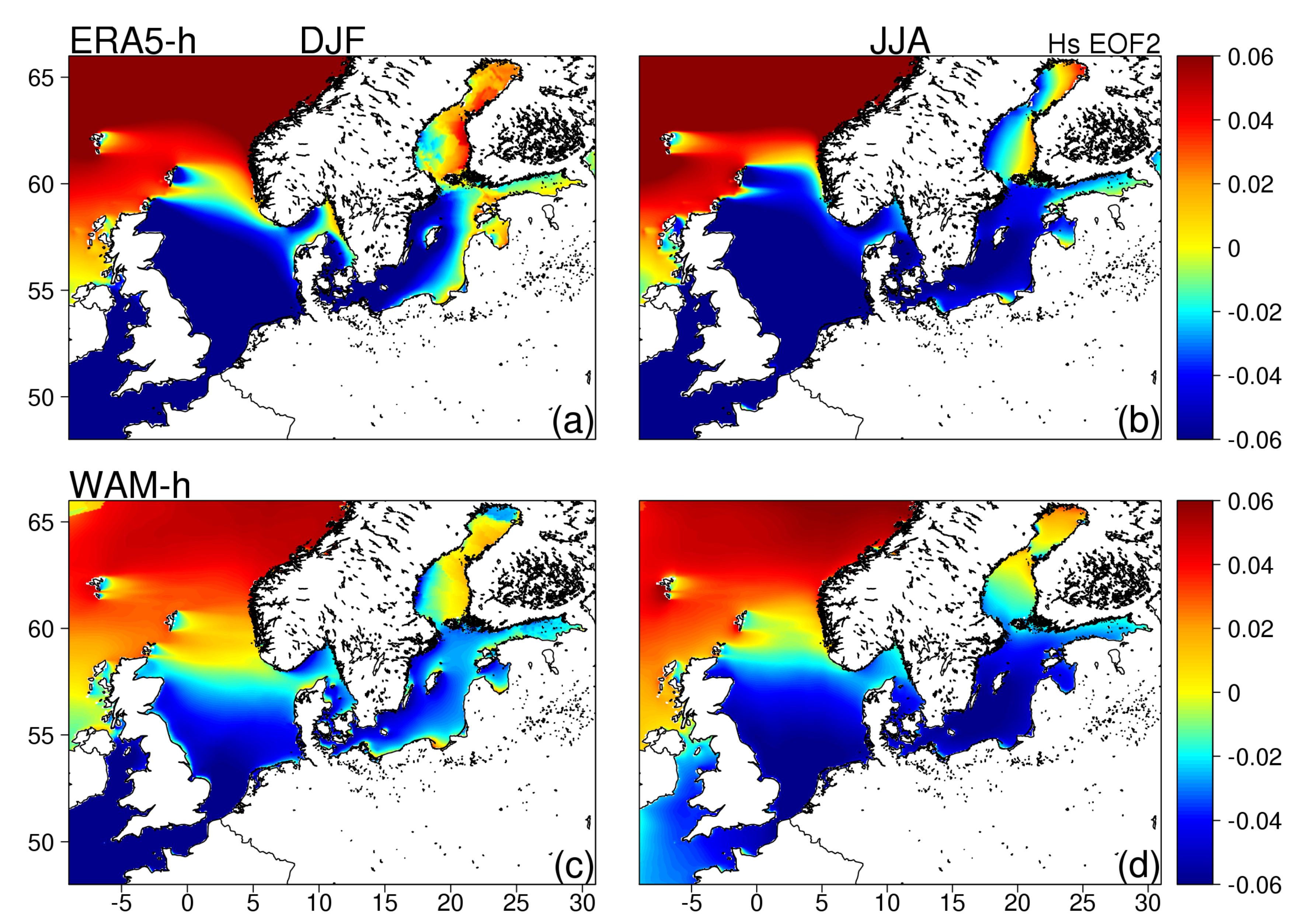

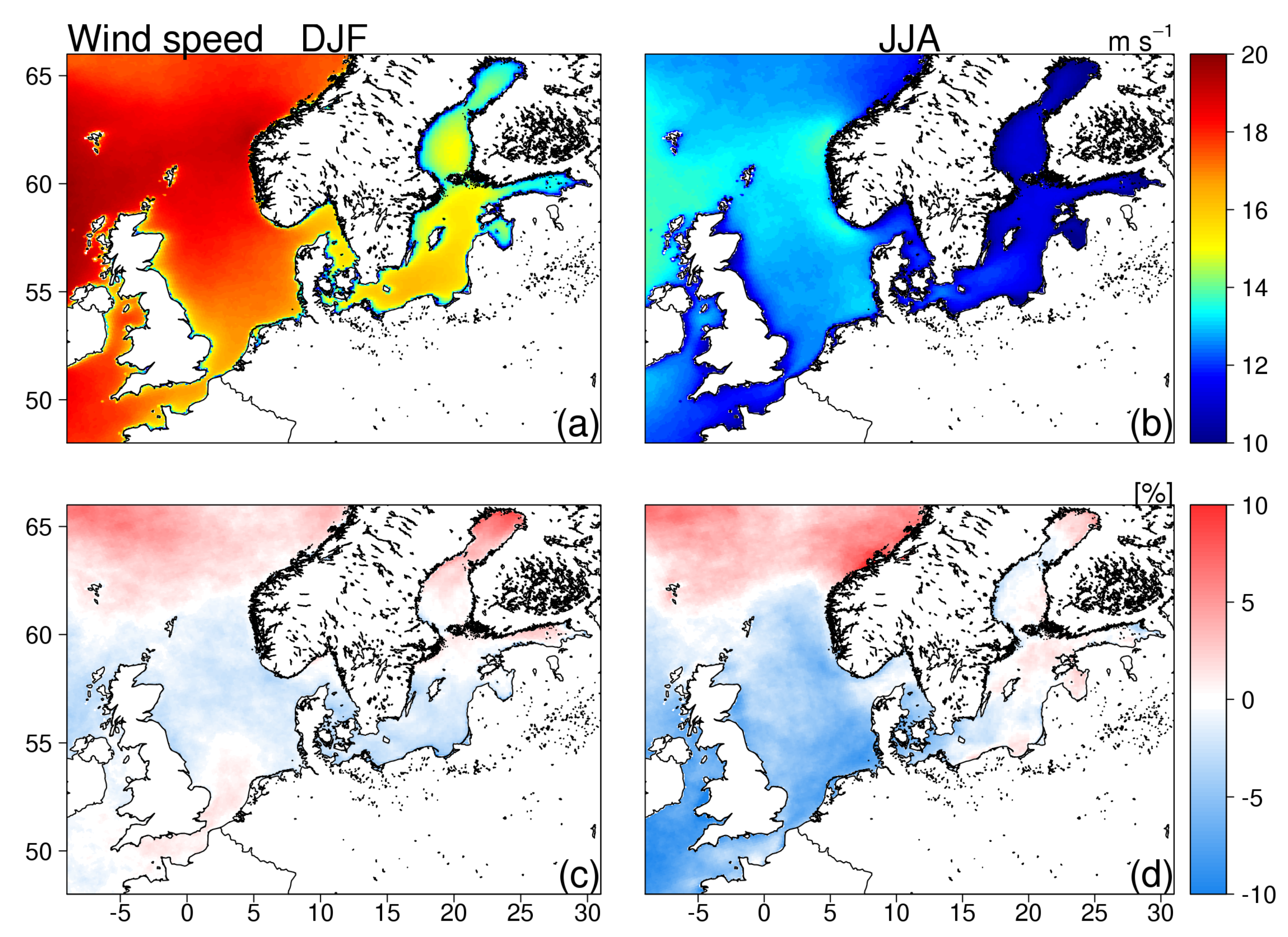
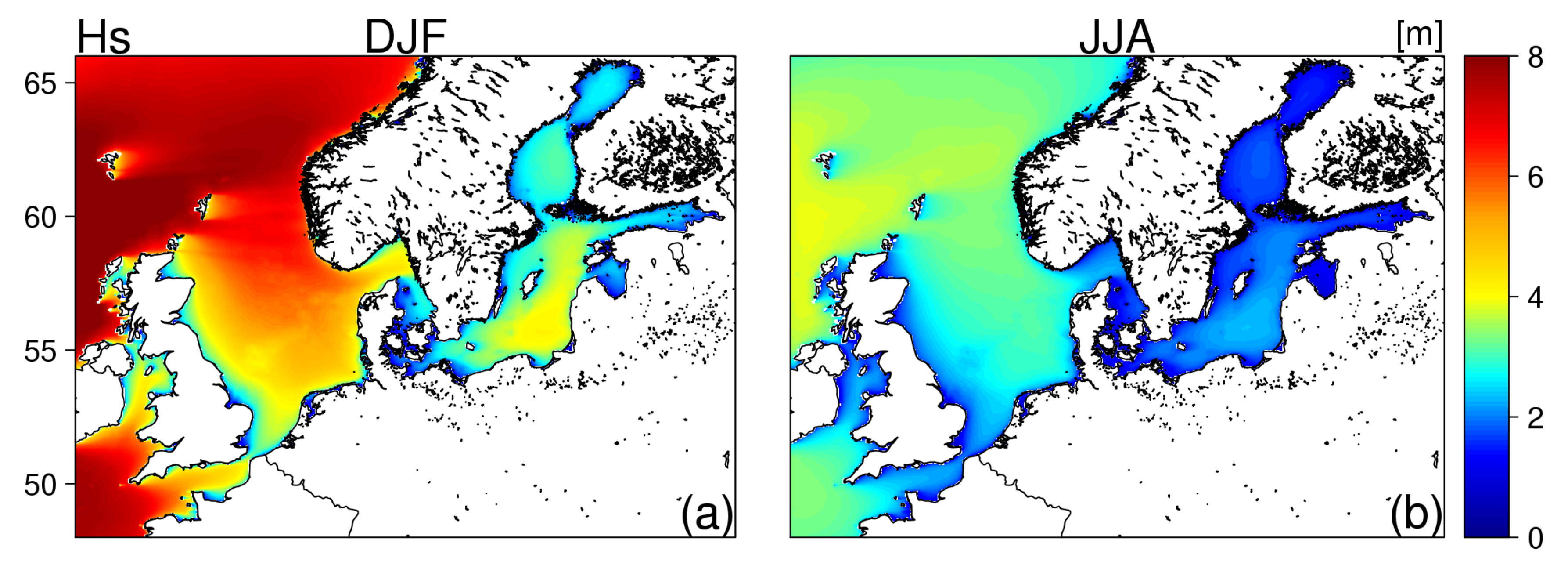
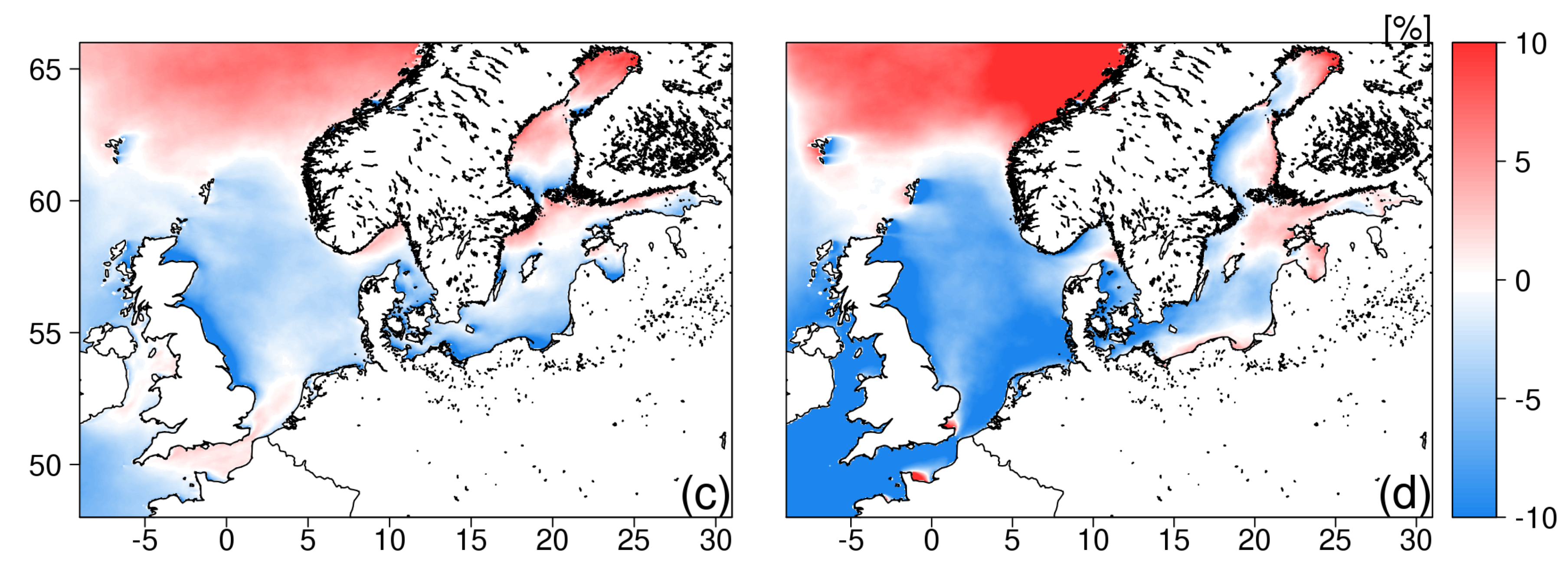
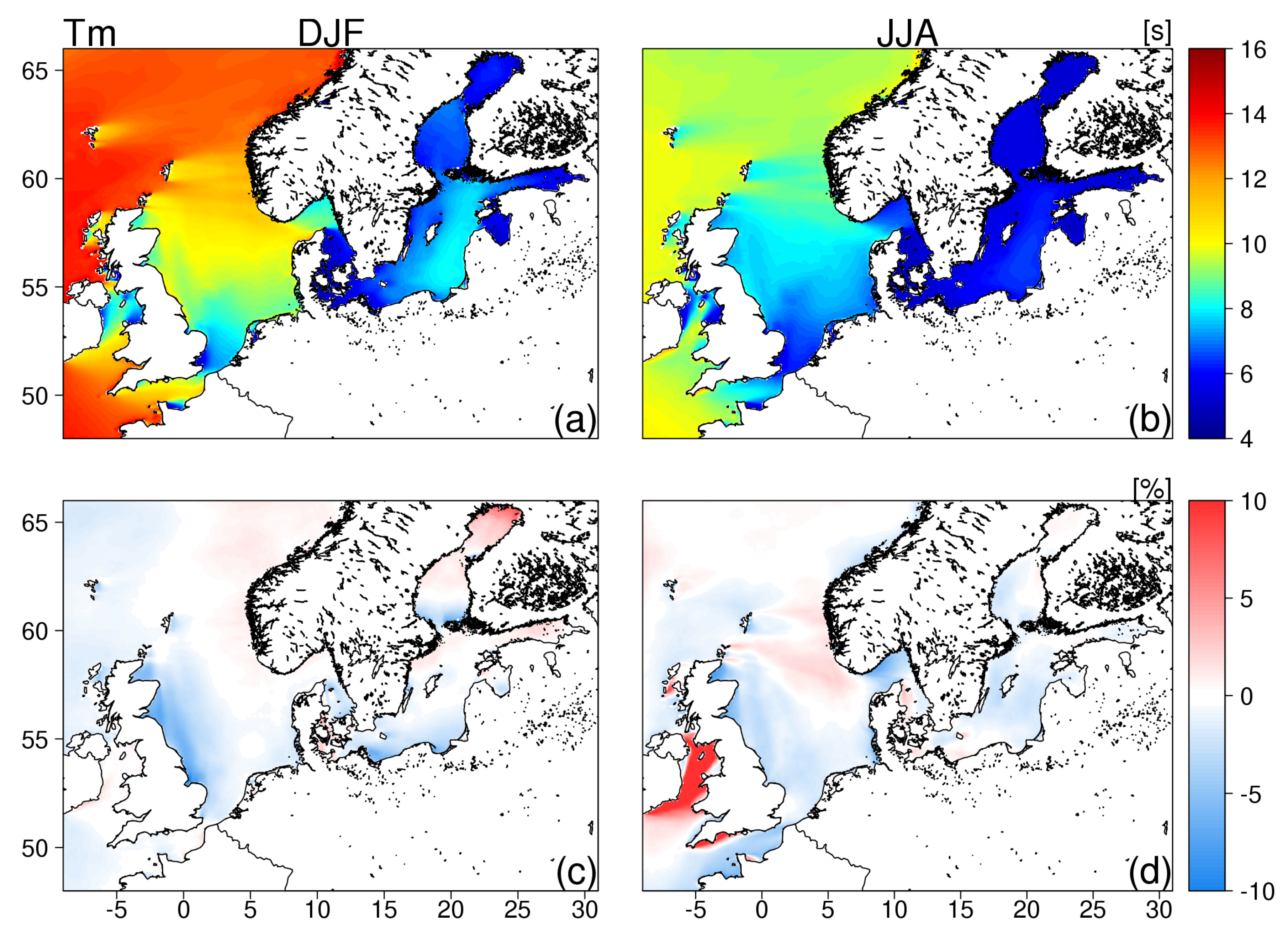

| ERA5-h | NORA10-h | WAM | |||||||
|---|---|---|---|---|---|---|---|---|---|
| FULL | 0.99 | 0.09 | 7.78 | 0.93 | 0.06 | 12.28 | 0.89 | 0.18 | 20.22 |
| NA | 0.99 | −0.01 | 2.96 | 0.91 | −0.05 | 15.08 | 0.88 | 0.13 | 18.75 |
| NS | 0.99 | 0.02 | 3.69 | 0.92 | 0.09 | 16.24 | 0.76 | 0.17 | 24.98 |
| SK | 0.96 | 0.04 | 12.56 | 0.80 | 0.01 | 23.63 | 0.64 | 0.07 | 34.77 |
| BA | 0.98 | 0.04 | 8.16 | 0.95 | 0.09 | 15.98 | 0.71 | 0.15 | 31.3 |
| OBS | ERA5-h | NORA10-h | WAM | C | C | C | |
|---|---|---|---|---|---|---|---|
| PC1(FULL) | 46.53 | 48.24 | 40.79 | 47.99 | 0.99 | 0.94 | 0.91 |
| PC2(FULL) | 10.84 | 11.44 | 10.39 | 8.19 | 0.98 | 0.66 | 0.51 |
| PC1(NA) | 60.54 | 63.03 | 57.32 | 65.60 | 0.99 | 0.91 | 0.89 |
| PC2(NA) | 13.77 | 13.05 | 12.78 | 10.03 | 0.99 | 0.57 | 0.6 |
| PC1(NS) | 44.78 | 45.18 | 51.49 | 44.72 | 0.99 | 0.94 | 0.76 |
| PC2(NS) | 17.20 | 19.54 | 15.82 | 15.84 | 0.99 | 0.58 | 0.36 |
| PC1(SK) | 34.65 | 32.99 | 47.48 | 40.22 | 0.78 | 0.25 | 0.36 |
| PC2(SK) | 28.70 | 27.77 | 30.48 | 23.11 | 0.68 | 0.05 | 0.14 |
| PC1(BA) | 43.89 | 40.66 | 35.37 | 32.93 | 0.98 | 0.94 | 0.74 |
| PC2(BA) | 11.43 | 12.41 | 12.32 | 13.44 | 0.89 | 0.36 | 0.1 |
| ERA5-h DJF | WAM DJF | WAM-f DJF | ERA5-h JJA | WAM JJA | WAM-f JJA | |
|---|---|---|---|---|---|---|
| EOF1(ALL) | 58.76 | 58.29 | 61.6 | 41.28 | 47.64 | 45.08 |
| EOF2(ALL) | 15.37 | 15.72 | 16.10 | 22.46 | 18.26 | 20.8 |
| EOF1(NA) | 90.22 | 87.54 | 92.32 | 77.87 | 81.33 | 86.38 |
| EOF2(NA) | 4.93 | 5.14 | 3.11 | 10.17 | 6.12 | 5.18 |
| EOF1(NS) | 80.03 | 78.45 | 80.21 | 78.77 | 78.69 | 76.80 |
| EOF2(NS) | 11.86 | 9.25 | 11.12 | 9.20 | 10.34 | 12.96 |
| EOF1(SK) | 82.10 | 69.93 | 76.67 | 73.13 | 68.08 | 58.69 |
| EOF2(SK) | 9.88 | 14.67 | 10.43 | 16.10 | 18.37 | 24.47 |
| EOF1(BA) | 57.26 | 62.17 | 60 | 64.80 | 61.56 | 57.65 |
| EOF2(BA) | 13.53 | 13.51 | 17.2 | 14.90 | 17.70 | 19.7 |
| ERA5-h DJF | WAM DJF | WAM-f DJF | ERA5-h JJA | WAM JJA | WAM-f JJA | |
|---|---|---|---|---|---|---|
| EOF1(ALL) | 50.97 | 48.56 | 52.9 | 34.78 | 40.39 | 38.1 |
| EOF2(ALL) | 18.57 | 19.92 | 21.64 | 22.05 | 19.59 | 22.76 |
| EOF1(NA) | 77.97 | 65.02 | 79.75 | 59.49 | 70.01 | 77.99 |
| EOF2(NA) | 8.25 | 17.83 | 6.27 | 13.34 | 9.67 | 8.94 |
| EOF1(NS) | 83.08 | 80.00 | 81.91 | 72.81 | 71.47 | 65.77 |
| EOF2(NS) | 9.47 | 11.80 | 11.40 | 9.31 | 14.84 | 17.92 |
| EOF1(SK) | 87.91 | 76.26 | 81.89 | 77.33 | 73.04 | 62.43 |
| EOF2(SK) | 4.78 | 9.40 | 7.59 | 13.33 | 14.42 | 21.20 |
| EOF1(BA) | 56.29 | 69.89 | 64.99 | 63.33 | 61.46 | 57.93 |
| EOF2(BA) | 13.92 | 12.67 | 15.97 | 15.54 | 18.04 | 19.13 |
© 2019 by the authors. Licensee MDPI, Basel, Switzerland. This article is an open access article distributed under the terms and conditions of the Creative Commons Attribution (CC BY) license (http://creativecommons.org/licenses/by/4.0/).
Share and Cite
Bonaduce, A.; Staneva, J.; Behrens, A.; Bidlot, J.-R.; Wilcke, R.A.I. Wave Climate Change in the North Sea and Baltic Sea. J. Mar. Sci. Eng. 2019, 7, 166. https://doi.org/10.3390/jmse7060166
Bonaduce A, Staneva J, Behrens A, Bidlot J-R, Wilcke RAI. Wave Climate Change in the North Sea and Baltic Sea. Journal of Marine Science and Engineering. 2019; 7(6):166. https://doi.org/10.3390/jmse7060166
Chicago/Turabian StyleBonaduce, Antonio, Joanna Staneva, Arno Behrens, Jean-Raymond Bidlot, and Renate Anna Irma Wilcke. 2019. "Wave Climate Change in the North Sea and Baltic Sea" Journal of Marine Science and Engineering 7, no. 6: 166. https://doi.org/10.3390/jmse7060166
APA StyleBonaduce, A., Staneva, J., Behrens, A., Bidlot, J.-R., & Wilcke, R. A. I. (2019). Wave Climate Change in the North Sea and Baltic Sea. Journal of Marine Science and Engineering, 7(6), 166. https://doi.org/10.3390/jmse7060166





